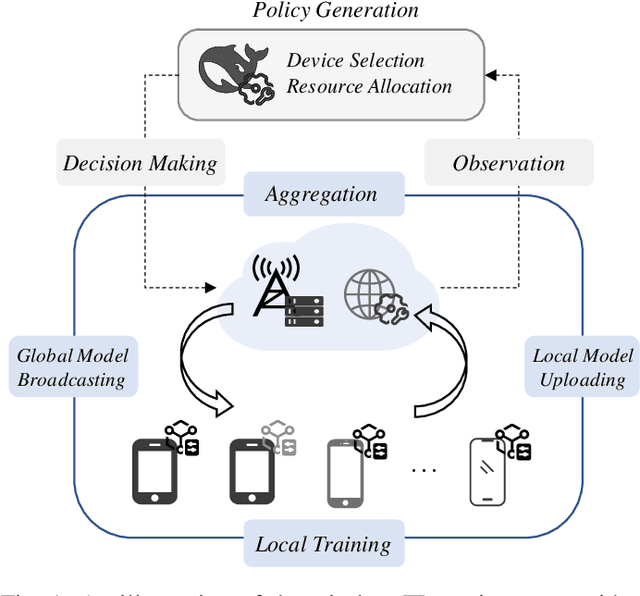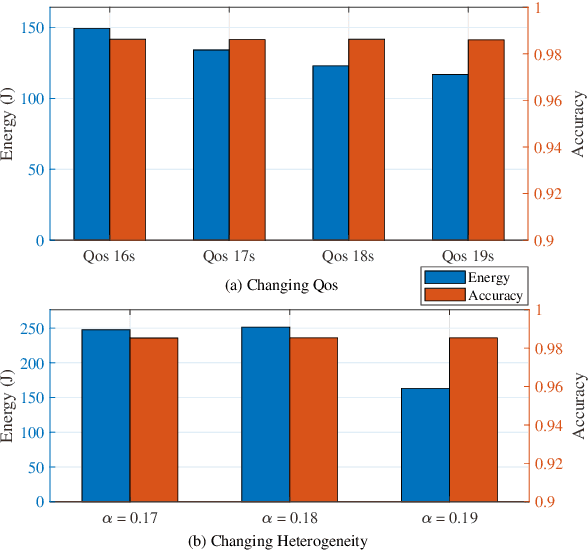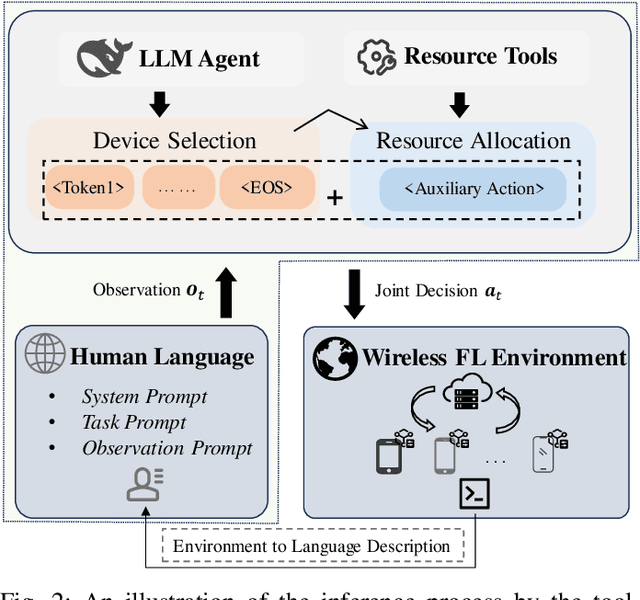Honggang Zhang
V-Thinker: Interactive Thinking with Images
Nov 06, 2025Abstract:Empowering Large Multimodal Models (LMMs) to deeply integrate image interaction with long-horizon reasoning capabilities remains a long-standing challenge in this field. Recent advances in vision-centric reasoning explore a promising "Thinking with Images" paradigm for LMMs, marking a shift from image-assisted reasoning to image-interactive thinking. While this milestone enables models to focus on fine-grained image regions, progress remains constrained by limited visual tool spaces and task-specific workflow designs. To bridge this gap, we present V-Thinker, a general-purpose multimodal reasoning assistant that enables interactive, vision-centric thinking through end-to-end reinforcement learning. V-Thinker comprises two key components: (1) a Data Evolution Flywheel that automatically synthesizes, evolves, and verifies interactive reasoning datasets across three dimensions-diversity, quality, and difficulty; and (2) a Visual Progressive Training Curriculum that first aligns perception via point-level supervision, then integrates interactive reasoning through a two-stage reinforcement learning framework. Furthermore, we introduce VTBench, an expert-verified benchmark targeting vision-centric interactive reasoning tasks. Extensive experiments demonstrate that V-Thinker consistently outperforms strong LMM-based baselines in both general and interactive reasoning scenarios, providing valuable insights for advancing image-interactive reasoning applications.
Amadeus: Autoregressive Model with Bidirectional Attribute Modelling for Symbolic Music
Aug 28, 2025Abstract:Existing state-of-the-art symbolic music generation models predominantly adopt autoregressive or hierarchical autoregressive architectures, modelling symbolic music as a sequence of attribute tokens with unidirectional temporal dependencies, under the assumption of a fixed, strict dependency structure among these attributes. However, we observe that using different attributes as the initial token in these models leads to comparable performance. This suggests that the attributes of a musical note are, in essence, a concurrent and unordered set, rather than a temporally dependent sequence. Based on this insight, we introduce Amadeus, a novel symbolic music generation framework. Amadeus adopts a two-level architecture: an autoregressive model for note sequences and a bidirectional discrete diffusion model for attributes. To enhance performance, we propose Music Latent Space Discriminability Enhancement Strategy(MLSDES), incorporating contrastive learning constraints that amplify discriminability of intermediate music representations. The Conditional Information Enhancement Module (CIEM) simultaneously strengthens note latent vector representation via attention mechanisms, enabling more precise note decoding. We conduct extensive experiments on unconditional and text-conditioned generation tasks. Amadeus significantly outperforms SOTA models across multiple metrics while achieving at least 4$\times$ speed-up. Furthermore, we demonstrate training-free, fine-grained note attribute control feasibility using our model. To explore the upper performance bound of the Amadeus architecture, we compile the largest open-source symbolic music dataset to date, AMD (Amadeus MIDI Dataset), supporting both pre-training and fine-tuning.
We-Math 2.0: A Versatile MathBook System for Incentivizing Visual Mathematical Reasoning
Aug 14, 2025Abstract:Multimodal Large Language Models (MLLMs) have demonstrated impressive capabilities across various tasks, but still struggle with complex mathematical reasoning. Existing research primarily focuses on dataset construction and method optimization, often overlooking two critical aspects: comprehensive knowledge-driven design and model-centric data space modeling. In this paper, we introduce We-Math 2.0, a unified system that integrates a structured mathematical knowledge system, model-centric data space modeling, and a reinforcement learning (RL)-based training paradigm to comprehensively enhance the mathematical reasoning abilities of MLLMs. The key contributions of We-Math 2.0 are fourfold: (1) MathBook Knowledge System: We construct a five-level hierarchical system encompassing 491 knowledge points and 1,819 fundamental principles. (2) MathBook-Standard & Pro: We develop MathBook-Standard, a dataset that ensures broad conceptual coverage and flexibility through dual expansion. Additionally, we define a three-dimensional difficulty space and generate 7 progressive variants per problem to build MathBook-Pro, a challenging dataset for robust training. (3) MathBook-RL: We propose a two-stage RL framework comprising: (i) Cold-Start Fine-tuning, which aligns the model with knowledge-oriented chain-of-thought reasoning; and (ii) Progressive Alignment RL, leveraging average-reward learning and dynamic data scheduling to achieve progressive alignment across difficulty levels. (4) MathBookEval: We introduce a comprehensive benchmark covering all 491 knowledge points with diverse reasoning step distributions. Experimental results show that MathBook-RL performs competitively with existing baselines on four widely-used benchmarks and achieves strong results on MathBookEval, suggesting promising generalization in mathematical reasoning.
SketchAnimator: Animate Sketch via Motion Customization of Text-to-Video Diffusion Models
Aug 10, 2025



Abstract:Sketching is a uniquely human tool for expressing ideas and creativity. The animation of sketches infuses life into these static drawings, opening a new dimension for designers. Animating sketches is a time-consuming process that demands professional skills and extensive experience, often proving daunting for amateurs. In this paper, we propose a novel sketch animation model SketchAnimator, which enables adding creative motion to a given sketch, like "a jumping car''. Namely, given an input sketch and a reference video, we divide the sketch animation into three stages: Appearance Learning, Motion Learning and Video Prior Distillation. In stages 1 and 2, we utilize LoRA to integrate sketch appearance information and motion dynamics from the reference video into the pre-trained T2V model. In the third stage, we utilize Score Distillation Sampling (SDS) to update the parameters of the Bezier curves in each sketch frame according to the acquired motion information. Consequently, our model produces a sketch video that not only retains the original appearance of the sketch but also mirrors the dynamic movements of the reference video. We compare our method with alternative approaches and demonstrate that it generates the desired sketch video under the challenge of one-shot motion customization.
Annotation-Free Human Sketch Quality Assessment
Jul 28, 2025Abstract:As lovely as bunnies are, your sketched version would probably not do them justice (Fig.~\ref{fig:intro}). This paper recognises this very problem and studies sketch quality assessment for the first time -- letting you find these badly drawn ones. Our key discovery lies in exploiting the magnitude ($L_2$ norm) of a sketch feature as a quantitative quality metric. We propose Geometry-Aware Classification Layer (GACL), a generic method that makes feature-magnitude-as-quality-metric possible and importantly does it without the need for specific quality annotations from humans. GACL sees feature magnitude and recognisability learning as a dual task, which can be simultaneously optimised under a neat cross-entropy classification loss with theoretic guarantee. This gives GACL a nice geometric interpretation (the better the quality, the easier the recognition), and makes it agnostic to both network architecture changes and the underlying sketch representation. Through a large scale human study of 160,000 \doublecheck{trials}, we confirm the agreement between our GACL-induced metric and human quality perception. We further demonstrate how such a quality assessment capability can for the first time enable three practical sketch applications. Interestingly, we show GACL not only works on abstract visual representations such as sketch but also extends well to natural images on the problem of image quality assessment (IQA). Last but not least, we spell out the general properties of GACL as general-purpose data re-weighting strategy and demonstrate its applications in vertical problems such as noisy label cleansing. Code will be made publicly available at github.com/yanglan0225/SketchX-Quantifying-Sketch-Quality.
AirLLM: Diffusion Policy-based Adaptive LoRA for Remote Fine-Tuning of LLM over the Air
Jul 15, 2025Abstract:Operating Large Language Models (LLMs) on edge devices is increasingly challenged by limited communication bandwidth and strained computational and memory costs. Thus, cloud-assisted remote fine-tuning becomes indispensable. Nevertheless, existing Low-Rank Adaptation (LoRA) approaches typically employ fixed or heuristic rank configurations, and the subsequent over-the-air transmission of all LoRA parameters could be rather inefficient. To address this limitation, we develop AirLLM, a hierarchical diffusion policy framework for communication-aware LoRA adaptation. Specifically, AirLLM models the rank configuration as a structured action vector that spans all LoRA-inserted projections. To solve the underlying high-dimensional sequential decision-making problem, a Proximal Policy Optimization (PPO) agent generates coarse-grained decisions by jointly observing wireless states and linguistic complexity, which are then refined via Denoising Diffusion Implicit Models (DDIM) to produce high-resolution, task- and channel-adaptive rank vectors. The two modules are optimized alternatively, with the DDIM trained under the Classifier-Free Guidance (CFG) paradigm to maintain alignment with PPO rewards. Experiments under varying signal-to-noise ratios demonstrate that AirLLM consistently enhances fine-tuning performance while significantly reducing transmission costs, highlighting the effectiveness of reinforcement-driven, diffusion-refined rank adaptation for scalable and efficient remote fine-tuning over the air.
RALLY: Role-Adaptive LLM-Driven Yoked Navigation for Agentic UAV Swarms
Jul 02, 2025Abstract:Intelligent control of Unmanned Aerial Vehicles (UAVs) swarms has emerged as a critical research focus, and it typically requires the swarm to navigate effectively while avoiding obstacles and achieving continuous coverage over multiple mission targets. Although traditional Multi-Agent Reinforcement Learning (MARL) approaches offer dynamic adaptability, they are hindered by the semantic gap in numerical communication and the rigidity of homogeneous role structures, resulting in poor generalization and limited task scalability. Recent advances in Large Language Model (LLM)-based control frameworks demonstrate strong semantic reasoning capabilities by leveraging extensive prior knowledge. However, due to the lack of online learning and over-reliance on static priors, these works often struggle with effective exploration, leading to reduced individual potential and overall system performance. To address these limitations, we propose a Role-Adaptive LLM-Driven Yoked navigation algorithm RALLY. Specifically, we first develop an LLM-driven semantic decision framework that uses structured natural language for efficient semantic communication and collaborative reasoning. Afterward, we introduce a dynamic role-heterogeneity mechanism for adaptive role switching and personalized decision-making. Furthermore, we propose a Role-value Mixing Network (RMIX)-based assignment strategy that integrates LLM offline priors with MARL online policies to enable semi-offline training of role selection strategies. Experiments in the Multi-Agent Particle Environment (MPE) environment and a Software-In-The-Loop (SITL) platform demonstrate that RALLY outperforms conventional approaches in terms of task coverage, convergence speed, and generalization, highlighting its strong potential for collaborative navigation in agentic multi-UAV systems.
Topology-Assisted Spatio-Temporal Pattern Disentangling for Scalable MARL in Large-scale Autonomous Traffic Control
Jun 14, 2025Abstract:Intelligent Transportation Systems (ITSs) have emerged as a promising solution towards ameliorating urban traffic congestion, with Traffic Signal Control (TSC) identified as a critical component. Although Multi-Agent Reinforcement Learning (MARL) algorithms have shown potential in optimizing TSC through real-time decision-making, their scalability and effectiveness often suffer from large-scale and complex environments. Typically, these limitations primarily stem from a fundamental mismatch between the exponential growth of the state space driven by the environmental heterogeneities and the limited modeling capacity of current solutions. To address these issues, this paper introduces a novel MARL framework that integrates Dynamic Graph Neural Networks (DGNNs) and Topological Data Analysis (TDA), aiming to enhance the expressiveness of environmental representations and improve agent coordination. Furthermore, inspired by the Mixture of Experts (MoE) architecture in Large Language Models (LLMs), a topology-assisted spatial pattern disentangling (TSD)-enhanced MoE is proposed, which leverages topological signatures to decouple graph features for specialized processing, thus improving the model's ability to characterize dynamic and heterogeneous local observations. The TSD module is also integrated into the policy and value networks of the Multi-agent Proximal Policy Optimization (MAPPO) algorithm, further improving decision-making efficiency and robustness. Extensive experiments conducted on real-world traffic scenarios, together with comprehensive theoretical analysis, validate the superior performance of the proposed framework, highlighting the model's scalability and effectiveness in addressing the complexities of large-scale TSC tasks.
Diffusion-Based Generative Models for 3D Occupancy Prediction in Autonomous Driving
May 29, 2025Abstract:Accurately predicting 3D occupancy grids from visual inputs is critical for autonomous driving, but current discriminative methods struggle with noisy data, incomplete observations, and the complex structures inherent in 3D scenes. In this work, we reframe 3D occupancy prediction as a generative modeling task using diffusion models, which learn the underlying data distribution and incorporate 3D scene priors. This approach enhances prediction consistency, noise robustness, and better handles the intricacies of 3D spatial structures. Our extensive experiments show that diffusion-based generative models outperform state-of-the-art discriminative approaches, delivering more realistic and accurate occupancy predictions, especially in occluded or low-visibility regions. Moreover, the improved predictions significantly benefit downstream planning tasks, highlighting the practical advantages of our method for real-world autonomous driving applications.
Tool-Aided Evolutionary LLM for Generative Policy Toward Efficient Resource Management in Wireless Federated Learning
May 16, 2025



Abstract:Federated Learning (FL) enables distributed model training across edge devices in a privacy-friendly manner. However, its efficiency heavily depends on effective device selection and high-dimensional resource allocation in dynamic and heterogeneous wireless environments. Conventional methods demand a confluence of domain-specific expertise, extensive hyperparameter tuning, and/or heavy interaction cost. This paper proposes a Tool-aided Evolutionary Large Language Model (T-ELLM) framework to generate a qualified policy for device selection in a wireless FL environment. Unlike conventional optimization methods, T-ELLM leverages natural language-based scenario prompts to enhance generalization across varying network conditions. The framework decouples the joint optimization problem mathematically, enabling tractable learning of device selection policies while delegating resource allocation to convex optimization tools. To improve adaptability, T-ELLM integrates a sample-efficient, model-based virtual learning environment that captures the relationship between device selection and learning performance, facilitating subsequent group relative policy optimization. This concerted approach reduces reliance on real-world interactions, minimizing communication overhead while maintaining high-fidelity decision-making. Theoretical analysis proves that the discrepancy between virtual and real environments is bounded, ensuring the advantage function learned in the virtual environment maintains a provably small deviation from real-world conditions. Experimental results demonstrate that T-ELLM outperforms benchmark methods in energy efficiency and exhibits robust adaptability to environmental changes.
 Add to Chrome
Add to Chrome Add to Firefox
Add to Firefox Add to Edge
Add to Edge